外研版必修2 Module 4 Fine Arts-Western, Chinese and Pop Arts Cultural corner and writing课件(29张ppt)
文档属性
| 名称 | 外研版必修2 Module 4 Fine Arts-Western, Chinese and Pop Arts Cultural corner and writing课件(29张ppt) |  | |
| 格式 | zip | ||
| 文件大小 | 1.3MB | ||
| 资源类型 | 教案 | ||
| 版本资源 | 外研版 | ||
| 科目 | 英语 | ||
| 更新时间 | 2022-01-28 12:12:25 | ||
图片预览

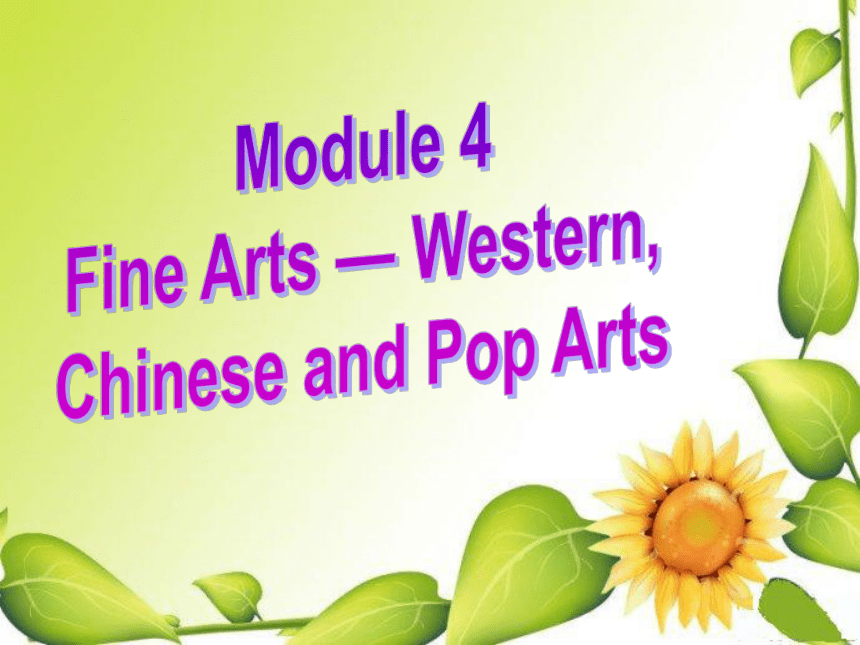
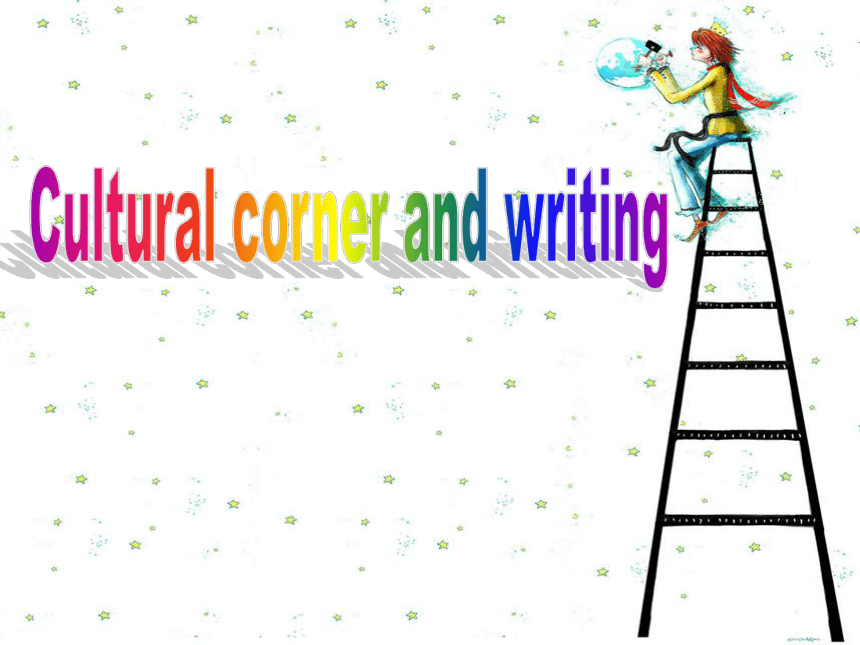
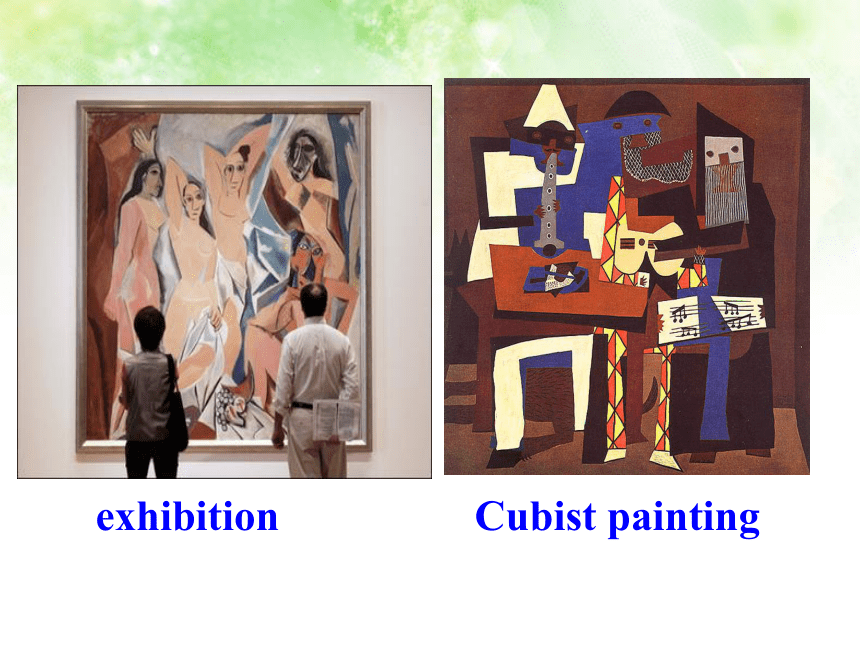
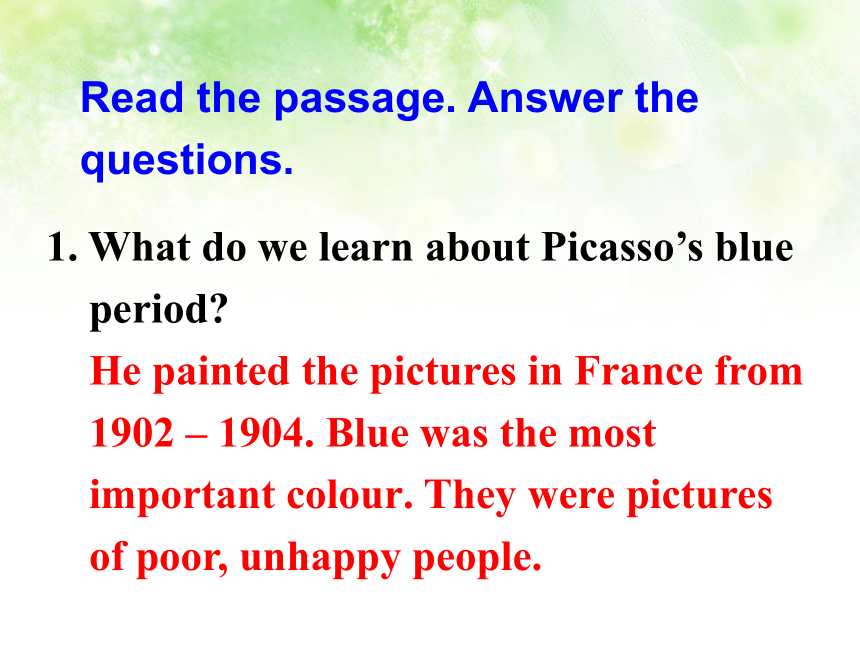
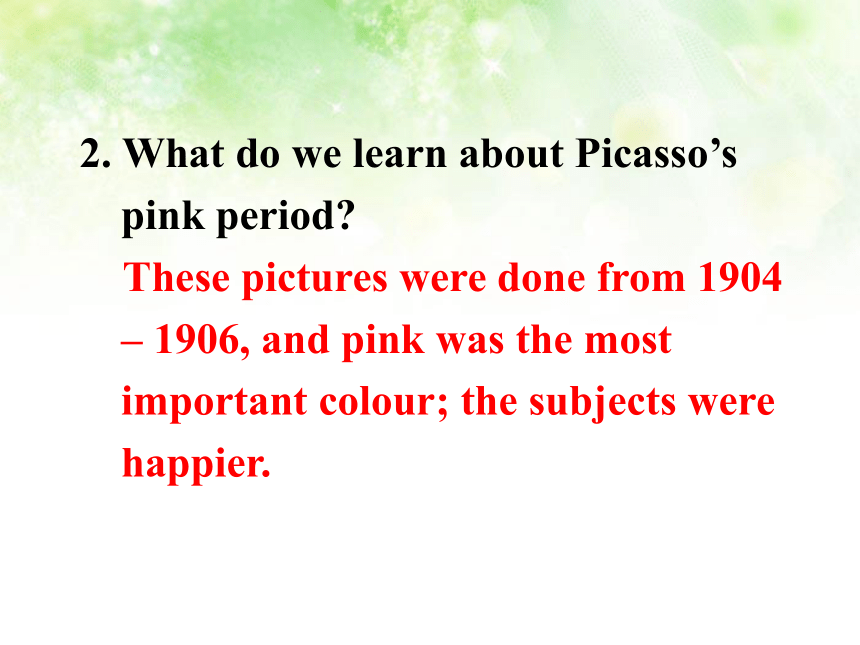
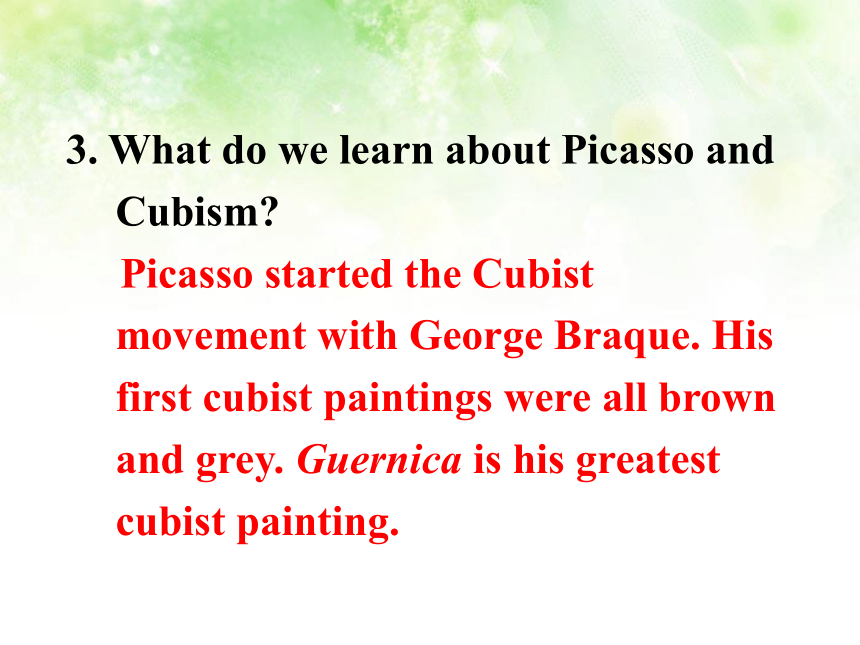

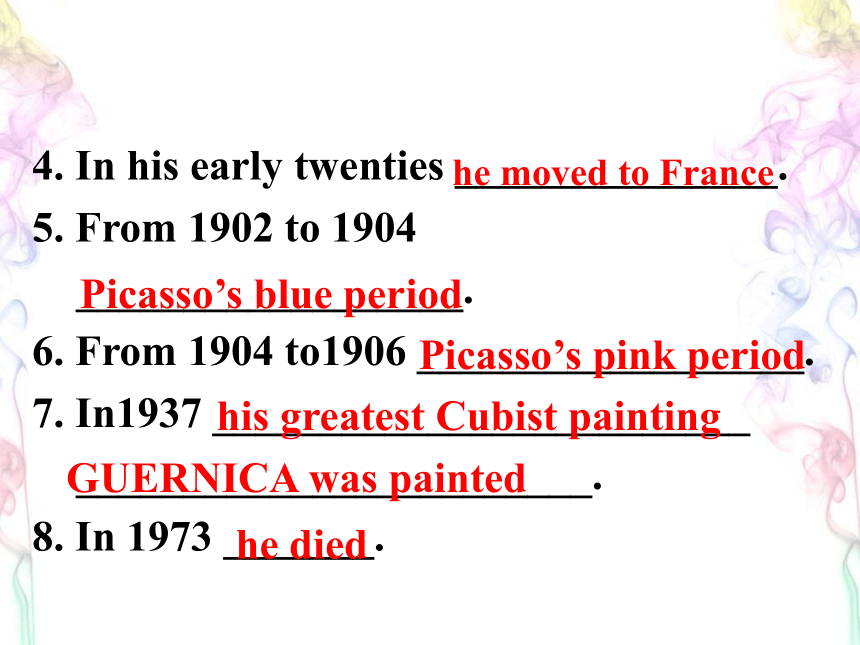
文档简介
(共29张PPT)
Cubist painting
exhibition
1. What do we learn about Picasso’s blue
period
He painted the pictures in France from
1902 – 1904. Blue was the most
important colour. They were pictures
of poor, unhappy people.
Read the passage. Answer the
questions.
2. What do we learn about Picasso’s pink period
These pictures were done from 1904 – 1906, and pink was the most important colour; the subjects were happier.
3. What do we learn about Picasso and Cubism
Picasso started the Cubist movement with George Braque. His first cubist paintings were all brown and grey. Guernica is his greatest cubist painting.
Read the text again and write down the facts about Picasso according the time clues.
1. In 1881 ___________________.
2. At the age of ten ______________
_______________.
3. At the age of 16
________________________________.
he was born in Spain
he was already
an excellent artist
he had his first exhibition
4. In his early twenties _______________.
5. From 1902 to 1904 __________________.
6. From 1904 to1906 __________________.
7. In1937 _________________________ ________________________.
8. In 1973 _______.
he moved to France
Picasso’s blue period
Picasso’s pink period
his greatest Cubist painting GUERNICA was painted
he died
From 1902 to 1904 he painted a series
of pictures where the main colour was
blue.
从1902年到1904年,他画了一幅又一幅主色调是蓝色的画。
a series of pictures 一副又一副的画
a series of good harvests 接连的丰收
a series of brilliant leaders 一个接一个的接触领袖
2. Picasso studied art in Spain, but
moved to France, in his early twenties.
毕加索在西班牙学习艺术,但他在二十出头的时候搬到了法国。
in his early twenties 在他二十出头的时候
in one’s early twenties 二十出头
Topic sentences
What is topic sentences?
主题句是指表达文章中心思想的句子。一般而言,每个段落都有一个主题句,而大多数主题句被安排在每一段的开头,有时在结尾,偶尔在段落中间,只要抓住了主题句就抓住了该段的意思。
Look at the passage in Reading and vocabulary activity 2.
The first sentences of paragraphs A-D are topic sentences.
Look at the sentences below. Put them into the right order to make a paragraph. Find the topic sentence first.
Their paintings were realistic, but the painters also wanted to show their feelings about the landscape.
2. These artists painted with
watercolours and inks, using soft
brushes.
3. Chinese landscape painting was at its
best over a thousand years ago, in the
time of the Song landscape artists.
4. They were very successful in achieving
both aims.
Answers:
3 – 2 – 1 – 4
The topic sentence is 3.
The relationships between topic sentences and supporting sentences.
主题句服务于文章的主题, 成为段落的中心, 受支撑句的阐述、解释; 支撑句直接服务于段落的主题, 间接服务于文章的主题。
如何写对比作文
【案例呈现】
假如你是一名学艺术的学生,请根据下表提示写一篇短文,谈谈中国画和西洋画的一些不同点,并说说你自己的喜好及理由。
中国画 西洋画 你的喜好及理由
1. 常以山水、花
鸟、人物为内
容;
2. 用毛笔、墨水绘
画,栩栩如生;
3. 代表人物:徐悲
鸿、齐白石。 1. 多以人物
肖像或实
物为内容;
2. 油画、水
彩画等;
3. 代表人物:
毕加索。 ……
注意:
1. 文章须包括以上所有要点,不要逐句翻译;
2. 词数:100左右;文章开头已给出,但不计入总词数;
3. 参考词汇:栩栩如生的 vivid。
There are differences between western and eastern styles of art. _____________
【写作指导】
●审题定调:
本文属于对比性说明文写作范畴,对比
之后可发表自己的看法。写作时应围绕
两者的不同点展开。
●布局谋篇: 全文分三段:
第一段:说明两者的不同点;
第二段:阐述不喜欢中国画 / 西洋画的
理由;
第三段:
阐述喜欢中国画 / 西洋画的理由。
注意事项:
1. 人称为第三人称和第一人称,以现在时态为主。
2. 在说明两者的不同点时,可采取集中比较法表达,形成A1、A2、A3 ... B1、B2、B3 ... 模式。(说明:如A代表中国画;B代表西洋画)。
常用表达:
描写异同点:
There are some similarities and also differences between A and B; A differs from B in ...; ... tell ... apart; while; but; however; on the other hand; compare A with B; for example
描写美术作品:
interesting; beautiful; lively; special; unique; lovely; vivid; real; excellent; extraordinary; wonderful; colourful; favorite; delightful; terrible; ugly; ordinary; perfect; beauty;
be known as / for ...; the style is close to ...; be easy / difficult / strange to understand; ... show the feelings / reality;
express their real feelings; ... aim to ...; look so alive; ... paint with ... in ...; the characteristics are ...; they stand for ...
发表自己的观点:
As far as I know, ...; I think ...; In my opinion ...; I prefer A to B; I’m crazy about ...; be tired of ...; be interested in ...; show interest in ...;
It makes a deep impression on me; I’m impressed by ...; enjoy; admire; appreciate; like; hate; I like it because (of) ...; be fond of ...
1. Finish the writing task.
2. Recite the key sentences and retell the first reading material on page 39.
3. Go over the two reading passages.
Cubist painting
exhibition
1. What do we learn about Picasso’s blue
period
He painted the pictures in France from
1902 – 1904. Blue was the most
important colour. They were pictures
of poor, unhappy people.
Read the passage. Answer the
questions.
2. What do we learn about Picasso’s pink period
These pictures were done from 1904 – 1906, and pink was the most important colour; the subjects were happier.
3. What do we learn about Picasso and Cubism
Picasso started the Cubist movement with George Braque. His first cubist paintings were all brown and grey. Guernica is his greatest cubist painting.
Read the text again and write down the facts about Picasso according the time clues.
1. In 1881 ___________________.
2. At the age of ten ______________
_______________.
3. At the age of 16
________________________________.
he was born in Spain
he was already
an excellent artist
he had his first exhibition
4. In his early twenties _______________.
5. From 1902 to 1904 __________________.
6. From 1904 to1906 __________________.
7. In1937 _________________________ ________________________.
8. In 1973 _______.
he moved to France
Picasso’s blue period
Picasso’s pink period
his greatest Cubist painting GUERNICA was painted
he died
From 1902 to 1904 he painted a series
of pictures where the main colour was
blue.
从1902年到1904年,他画了一幅又一幅主色调是蓝色的画。
a series of pictures 一副又一副的画
a series of good harvests 接连的丰收
a series of brilliant leaders 一个接一个的接触领袖
2. Picasso studied art in Spain, but
moved to France, in his early twenties.
毕加索在西班牙学习艺术,但他在二十出头的时候搬到了法国。
in his early twenties 在他二十出头的时候
in one’s early twenties 二十出头
Topic sentences
What is topic sentences?
主题句是指表达文章中心思想的句子。一般而言,每个段落都有一个主题句,而大多数主题句被安排在每一段的开头,有时在结尾,偶尔在段落中间,只要抓住了主题句就抓住了该段的意思。
Look at the passage in Reading and vocabulary activity 2.
The first sentences of paragraphs A-D are topic sentences.
Look at the sentences below. Put them into the right order to make a paragraph. Find the topic sentence first.
Their paintings were realistic, but the painters also wanted to show their feelings about the landscape.
2. These artists painted with
watercolours and inks, using soft
brushes.
3. Chinese landscape painting was at its
best over a thousand years ago, in the
time of the Song landscape artists.
4. They were very successful in achieving
both aims.
Answers:
3 – 2 – 1 – 4
The topic sentence is 3.
The relationships between topic sentences and supporting sentences.
主题句服务于文章的主题, 成为段落的中心, 受支撑句的阐述、解释; 支撑句直接服务于段落的主题, 间接服务于文章的主题。
如何写对比作文
【案例呈现】
假如你是一名学艺术的学生,请根据下表提示写一篇短文,谈谈中国画和西洋画的一些不同点,并说说你自己的喜好及理由。
中国画 西洋画 你的喜好及理由
1. 常以山水、花
鸟、人物为内
容;
2. 用毛笔、墨水绘
画,栩栩如生;
3. 代表人物:徐悲
鸿、齐白石。 1. 多以人物
肖像或实
物为内容;
2. 油画、水
彩画等;
3. 代表人物:
毕加索。 ……
注意:
1. 文章须包括以上所有要点,不要逐句翻译;
2. 词数:100左右;文章开头已给出,但不计入总词数;
3. 参考词汇:栩栩如生的 vivid。
There are differences between western and eastern styles of art. _____________
【写作指导】
●审题定调:
本文属于对比性说明文写作范畴,对比
之后可发表自己的看法。写作时应围绕
两者的不同点展开。
●布局谋篇: 全文分三段:
第一段:说明两者的不同点;
第二段:阐述不喜欢中国画 / 西洋画的
理由;
第三段:
阐述喜欢中国画 / 西洋画的理由。
注意事项:
1. 人称为第三人称和第一人称,以现在时态为主。
2. 在说明两者的不同点时,可采取集中比较法表达,形成A1、A2、A3 ... B1、B2、B3 ... 模式。(说明:如A代表中国画;B代表西洋画)。
常用表达:
描写异同点:
There are some similarities and also differences between A and B; A differs from B in ...; ... tell ... apart; while; but; however; on the other hand; compare A with B; for example
描写美术作品:
interesting; beautiful; lively; special; unique; lovely; vivid; real; excellent; extraordinary; wonderful; colourful; favorite; delightful; terrible; ugly; ordinary; perfect; beauty;
be known as / for ...; the style is close to ...; be easy / difficult / strange to understand; ... show the feelings / reality;
express their real feelings; ... aim to ...; look so alive; ... paint with ... in ...; the characteristics are ...; they stand for ...
发表自己的观点:
As far as I know, ...; I think ...; In my opinion ...; I prefer A to B; I’m crazy about ...; be tired of ...; be interested in ...; show interest in ...;
It makes a deep impression on me; I’m impressed by ...; enjoy; admire; appreciate; like; hate; I like it because (of) ...; be fond of ...
1. Finish the writing task.
2. Recite the key sentences and retell the first reading material on page 39.
3. Go over the two reading passages.
